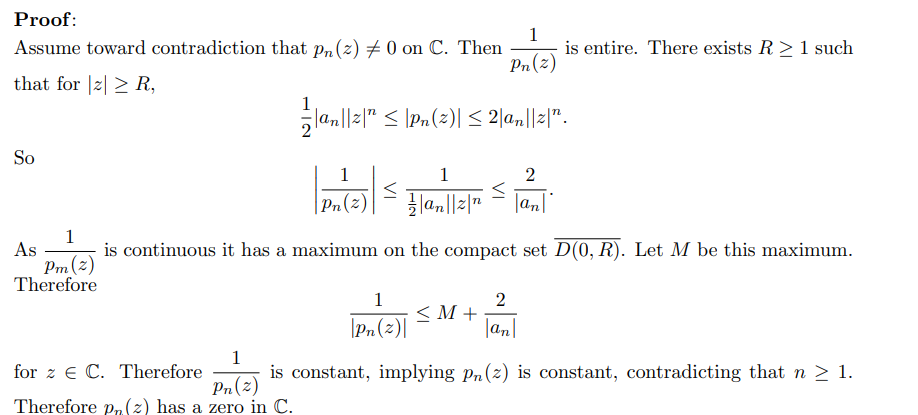Argument Principle
- Let \(P(z) = a_nz^n + \cdots + a_0\) and \(g(z) = P'(z)/P(z)\), note \(P\) is holomorphic
- Since \(\lim_{{\left\lvert {z} \right\rvert} \to \infty} P(z) = \infty\), there exist an \(R>0\) such that \(P\) has no roots in \(\left\{{{\left\lvert {z} \right\rvert} \geq R}\right\}\).
-
Apply the argument principle:
\begin{align*} N(0) = {1\over 2\pi i} \oint_{{\left\lvert {\xi} \right\rvert} = R} g(\xi) \,d\xi .\end{align*} - Check that \(\lim_{{\left\lvert {z\to \infty} \right\rvert}}zg(z) = n\), so \(g\) has a simple pole at \(\infty\)
- Then \(g\) has a Laurent series \({n\over z} + {c_2 \over z^2} + \cdots\)
- Integrate term-by-term to get \(N(0) = n\).
Rouche’s Theorem

- Let \(P(z) = a_nz^n + \cdots + a_0\)
- Set \(f(z) = a_n z^n\) and \(g(z) = P(z) - f(z) = a_{n-1}z^{n-1} + \cdots + a_0\), so \(f+g = P\).
- Choose \(R > \max\qty{ { {\left\lvert {a_{n-1}} \right\rvert} + \cdots + {\left\lvert {a_0} \right\rvert} \over {\left\lvert {a_n} \right\rvert} }, 1}\), then
\begin{align*}
|g(z)|
&\coloneqq|a_{n-1}z^{n-1} + \cdots + a_1 z + a_0 | \\
&\leq |a_{n-1}z^{n-1}| + \cdots + |a_1 z| + |a_0 | \quad\text{by the triangle inequality} \\
&= |a_{n-1}|\cdot |z^{n-1}| + \cdots + |a_1|\cdot| z| + |a_0 | \\
&= |a_{n-1}|\cdot R^{n-1} + \cdots + |a_1| R + |a_0 | \\
&\leq |a_{n-1}|\cdot R^{n-1}+|a_{n-2}|\cdot R^{n-1} + \cdots + |a_1| \cdot R^{n-1} + |a_0 |\cdot R^{n-1} \quad\text{since } R>1 \implies R^{a+b} \geq R^a \\
&= R^{n-1} \left( |a_{n-1}| + |a_{n-2}| + \cdots + |a_1| + |a_0| \right) \\
&\leq R^{n-1} \left( |a_n|\cdot R \right) \quad\text{by choice of } R \\
&= R^{n} |a_n| \\
&= |a_n z^n| \\
&\coloneqq|f(z)|
\end{align*}
- Then \(a_n z^n\) has \(n\) zeros in \({\left\lvert {z} \right\rvert} < R\), so \(f+g\) also has \(n\) zeros.
Liouville’s Theorem



- Suppose \(p\) is nonconstant and has no roots, then \({1\over p}\) is entire. We will show it is also bounded and thus constant, a contradiction.
- Write \(p(z) = z^n \left(a_n + \frac{a_{n-1}}{z}+\dots+\frac{a_{0}}{z^{n}}\right)\)
-
Outside a disc:
- Note that \(p(z) \overset{z\to \infty }\to \infty\). so there exists an \(R\) large enough such that \({\left\lvert {p(z)} \right\rvert} \geq {1\over A}\) for any fixed chosen constant \(A\).
- Then \({\left\lvert { 1/p(z)} \right\rvert} \leq A\) outside of \({\left\lvert {z} \right\rvert} >R\), i.e. \(1/p(z)\) is bounded there.
-
Inside a disc:
- \(p\) is continuous with no roots and thus must be bounded below on \({\left\lvert {z} \right\rvert} < R\).
- \(p\) is entire and thus continuous, and since \(\overline{D}_r(0)\) is a compact set, \(p\) achieves a min \(A\) there
- Set \(C \coloneqq\min(A, B)\), then \({\left\lvert {p(z)} \right\rvert} \geq C\) on all of \({\mathbf{C}}\) and thus \({\left\lvert {1/p(z)} \right\rvert} \leq C\) everywhere.
- So \(1/p(z)\) is bounded an entire and thus constant by Liouville’s theorem – but this forces \(p\) to be constant. \(\contradiction\)
Open Mapping Theorem
- \(p\) induces a continuous map \({\mathbf{CP}}^1 \to {\mathbf{CP}}^1\)
- The continuous image of compact space is compact;
- Since the codomain is Hausdorff space, the image is closed.
- \(p\) is holomorphic and non-constant, so by the Open Mapping Theorem, the image is open.
- Thus the image is clopen in \({\mathbf{CP}}^1\).
- The image is nonempty, since \(p(1) = \sum a_i \in {\mathbf{C}}\)
- \({\mathbf{CP}}^1\) is connected
- But the only nonempty clopen subset of a connected space is the entire space.
- So \(p\) is surjective, and \(p^{-1}(0)\) is nonempty.
- So \(p\) has a root.
Generalized Liouville
If \(X\) is a compact complex manifold, any holomorphic \(f:X\to {\mathbf{C}}\) is constant.
If \(f:X\to Y\) is a nonconstant holomorphic map between Riemann surfaces with \(X\) compact, then
- \(f\) must be surjective,
- \(Y\) must be compact,
- \(f^{-1}(q)\) is finite for all \(q\in Y\),
- The branch and ramification loci consist of finitely many points.
Given a nonconstant \(p\in {\mathbf{C}}[x]\), regard it as a function \(p: {\mathbf{P}}^1({\mathbf{C}}) \to {\mathbf{P}}^1({\mathbf{C}})\) by extending so that \(p(\infty) = \infty\). Since \(p\) is nonconstant, by the lemma \(p\) is surjective, so there exists some \(x\neq \infty\) in \({\mathbf{P}}^1({\mathbf{C}})\) with \(p(x) = 0\).